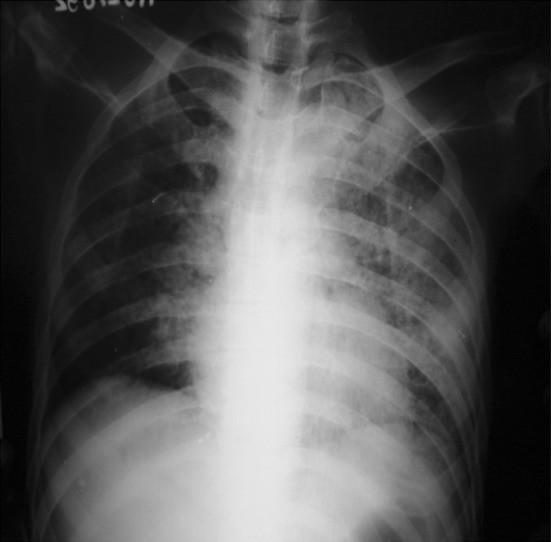Abstract
We report a case of hairy cell leukemia who improved after cladribine but succumbed to disseminated atypical mycobacterial infection 2 months after completing cladribine.
Case Report
A 50-year-old male was admitted with high grade continuous fever for 1 month duration. There was no clinical and radiological evidence of tuberculosis. He had moderate pallor but no petechiae, lymphadenopathy, bone pain or jaundice. Cardiovascular and respiratory examination was normal. Abdomen examination revealed moderate splenomegaly, 7 cm below the left costal margin. His hemogram showed bicytopenia with hemoglobin of 7.0 g/dl, total leukocyte count 3,300/μl, polymorphs 21 %, lymphocytes 79 % and platelet count 2,67,000/μl. Peripheral smear showed hair like projections in some of the lymphocytes. Bone marrow biopsy showed hypercellular bone marrow with diffuse infiltration by lymphoid cells, increased marrow fibrosis, and fried egg appearance characteristic of hairy cell leukemia. The lymphoid cells were positive for CD19, CD25, CD11c, CD45 and CD103 confirming the diagnosis of hairy cell leukemia.
Renal, liver function tests were normal and HIV was negative. Roentgenogram of the chest was normal. His fever subsided with antibiotics and Cladribine was started at a dose of 0.09 mg/kg/day continuous infusion for 7 days. He developed febrile neutropenia which was treated with vancomycin, meropenem and voriconazole. He also received G-CSF injections for 14 days. Splenomegaly regressed and his hemogram was normal. Patient was discharged after 2 months of hospital stay.
On follow up, he developed leukopenia (TC––2,800/cumm3) 1 month after discharge and the repeat bone marrow showed occasional hairy cells with post chemotherapeutic changes. He received acyclovir, fluconazole and cotrimaxozole prophylaxis.
Two weeks later patient developed intermittent dry cough and anorexia but there was no fever or breathlessness. CECT thorax and abdomen done 10 days after the onset of dry cough was normal. Blood cultures were sterile. A week later, patient presented to the emergency department with breathlessness for 1 day duration. He had coarse crepitations on the left interscapular and infra-axillary region. ABG showed PaO2 of 86 mmHg and the chest X-ray showed revealed bilateral interstitial infiltrates more on the left side (Fig. 1). Therapeutic doses of cotrimoxazole were given considering pneumocystis jiroveci Pneumonia. Antituberculosis treatment with isoniazid, rifampicin, pyrazinamide and ethambutol was started along with azithromycin to cover atypical mycobacterial infections. He deteriorated and expired within 24 h of hospital stay.
Fig. 1.

Chest X-ray showing pulmonary infiltrates
Post mortem lung biopsy was done which showed plenty of long, slender acid fast bacilli. Atypical mycobacterial infection was considered in view of long slender bacilli (Fig. 2). Blood culture was sterile.
Fig. 2.

Post mortem lung biopsy (10,156/10)—showing long slender bacilli in AFS (×1,000)
Discussion
Patients who have HCL are predisposed to infections because of neutropenia, impaired neutrophil microbicidal function, monocytopenia, monocyte dysfunction, and marked deficiency in circulating dendritic cells and due to chemotherapy. Although gram-positive and gram-negative infections are common in patients with neutropenia, patients with HCL have predilection to tuberculosis, atypical mycobacterial and fungal infections.
With the advent of interferon therapy and the induction of disease remission, infection as a cause of death declined [1, 2]. In the era of purine analog therapy, infectious complications have become rare [3].
There are reports of atypical mycobacterial infections associated with HCL, specifically, Mycobacterium avium-intracellulare complex, M. kansasii, M. intracellulare, M. malmoense, M. szulgai, and M. chelonae, mainly secondary to neutropenia and immunosuppression caused by chemotherapy. [4].
The incidence of atypical mycobacterial infections in hairy cell leukemia ranges between 5–10 % in various studies. Invasive diagnostic studies, including bronchoscopy, thoracotomy and laparotomy will be necessary for confirmation of the diagnosis of atypical mycobacteria infection. Bennett et al. [4] reported nine cases of atypical mycobacterial infections (biopsy/culture proven) in 186 patients with hairy cell leukemia who were seen over 10 years. Majority of patients in this report by Bennett et al. was treated empirically (6 out of 9) for atypical mycobacterial infections before confirmatory diagnosis and only five of the nine patients survived the infection.
Treatment for disseminated disease caused by MAC is Clarithromycin (500 mg PO bid) or azithromycin (500 mg daily) plus Ethambutol (15 mg/kg qd). For rifampin-susceptible strains of M. kansasii, the recommended regimen is daily rifampin (600 mg), isoniazid (300 mg), and ethambutol (15 mg/kg) [5].
In our patient considering the short duration of symptoms, normal CT thorax and abdomen a week before the deterioration and morphology of the mycobacteria in the post-mortem lung biopsy specimen the acute illness and deterioration can be attributed to atypical mycobacterial infection.
Conclusion
Awareness of the association between hairy cell leukemia and atypical mycobacteria infection is important, as early consideration of invasive diagnostic studies and empirical therapy against atypical mycobacterial infections, may prevent death in this treatable leukemia.
Contributor Information
ChandraMohan Ramasamy, Email: chandramohan.rcm@gmail.com.
Biswajit Dubashi, Email: drbiswajitd@yahoo.com.
J. Sree Rekha, Email: jsrekha_177@yahoo.com
Debdatta Basu, Email: drbiswajitd@yahoomail.com.
Ankit Jain, Email: ankitjaindm@gmail.com.
Tarun Kumar Dutta, Email: tkdutta@yahoo.co.in.
References
- 1.Cannon T, Mobarek D, Wegge J, Tabbara AI. Hairy cell leukemia: current concepts. Cancer Invest. 2008;26:860–865. doi: 10.1080/07357900801965034. [DOI] [PubMed] [Google Scholar]
- 2.Golomb HM, Hadad LJ. Infectious complications in 127 patients with hairy cell leukemia. Am J Hematol. 1984;16:393–401. doi: 10.1002/ajh.2830160410. [DOI] [PubMed] [Google Scholar]
- 3.Goodman GR, Burian C, Koziol JA, et al. Extended follow-up of patients with hairy cell leukemia after treatment with cladribine. J Clin Oncol. 2003;21(5):891–896. doi: 10.1200/JCO.2003.05.093. [DOI] [PubMed] [Google Scholar]
- 4.Bennett C, Vardiman J, Golomb H. Disseminated atypical mycobacterial infection in patients with hairy cell leukemia. Am J Med. 1986;80:891–896. doi: 10.1016/0002-9343(86)90634-0. [DOI] [PubMed] [Google Scholar]
- 5.Griffith DE, et al. An official ATS/IDSA statement: diagnosis, treatment and prevention of nontuberculous mycobacterial diseases. Am J Respir Crit Care Med. 2007;175:367. doi: 10.1164/rccm.200604-571ST. [DOI] [PubMed] [Google Scholar]


